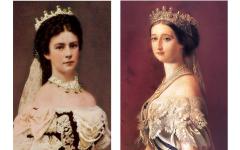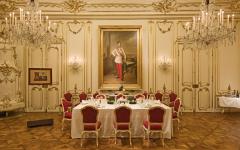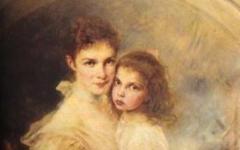IMPERIAL CHRISTMAS AT VIENNA HOFBURG with Franz Joseph, Elisabeth and their Children
The relationship between Archduchess Marie Valerie and Crown Prince Rudolf
Vienna Hofburg was the official winter residence of the Imperial family. They usually spent the Christmas season there. However, after the Hungarian coronation, the family often stayed in the Royal Palace of Gödöllő, Hungary too, and in her late ages, Elisabeth did not spend this holiday with her family. Sisi was born at the Holy Night so on 24th December her birthday was also celebrated. The royal family had a Christmas tree, which was decorated on the day of Christmas Eve. The dinner was held and the presents were given to each other in the late afternoon. The family gathering usually ended at around seven o’clock, when each family member returned to their own private apartments in Hofburg or at another residence.
Elisabeth did not like the atmosphere of the Viennese court from the very beginning of her marriage. The royal couple had four children in the following order: Sophie (who died at the age of two), Gisela (who got married at the age of 16, in 1873 – after that she usually celebrated the Christmas in her new home in Munich), Crown Prince Rudolf (who got married on 1881, he and his wife usually spent the Christmas Eve with the Imperial parents), the fourth child, Marie Valerie was born in 1868, and until her wedding in 1890, she spent the holiday with her parents.
Each of the children, Gisela, Rudolf and Valerie (from their young ages) and the Imperial couple, Elisabeth and Franz Joseph had their own households with own servants. According to Marie Valerie, the whole family rarely was together – only usually at special occasions – and when they met, they often could not talk about anything. Valeria wrote about the Christmas gatherings in her diary so also thanks to her memoirs, it is known that the atmosphere on Christmas Eve was embarrassing. For this “rigid and unfriendly” atmosphere Valerie put the blame on Stephanie, Rudolf’s wife stating that it was caused by the “coldness and heartlessness” of the Crown Prince’s wife.
In the montage: Small pictures - 1. Marie Valerie (photo: Carl Pietzner). 2. Crown Prince Rudolf with Stephanie (1881 - photo: Géruzet Frères). 3. Crown Prince Rudolf (1887). Big picture: The Imperial family in Vienna Hofburg (the little girl is Erzsi, the only-daughter of the Crown Prince - Rudolf is on the right with Stephanie, Valerie is on the left, the Imperial couple is in the middle) - Wilhelm Gause, 1887

Valerie and Rudolf were not on good terms from the very beginning of the little princess’s life because the Crown Prince was very jealous of his sister. Rudolf loved her mother so much, however, Elisabeth did not really realise it or care about it. Sisi felt that both of her older surviving children, Gisela and Rudolf were brought up by Franz Joseph’s mother, Archduchess Sophie (also after the Empress had fought for her rights as a mother) – she could never forgive her mother-in-law for taking away the children from her even after the Archduchess’ death in 1872. Among the children, it was Rudolf who took after his mother the most, he had a similar sensitive personality and imagination like Elisabeth had, besides, they had many similar views regarding to politics. Sisi did not know her son at all and did not know about all these things. After Valerie had been born, Elisabeth kept away her from everybody, especially from Archduchess Sophie. She became an overprotective mother. Not only Rudolf but also Valerie, herself was suffering from this attitude. Elisabeth cared only about her believing she was “her only-one” – she did not let anybody interfere in the way she brought up her daughter. Rudolf was jealous of and often rude to his sister, not surprisingly: Valerie got all their mother’s attention and love, which he rarely got. Marie Valerie usually was afraid of her brother and because of it, Elisabeth was angry with Rudolf and protected Valerie even more.
In conclusion of the above-mentioned facts, we can hardly talk about affectionate Christmas Eves regarding to Hofburg. However, there were some occasions when the family members were able to express their love towards each other. In the second part of my article, I intend to recall some of these rare moments of Christmas time in Hofburg. From two of the three affectionate occasions that I will write about took place in Elisabeth’s dressing room, and the other one in the family salon (the Alexander Room, which is next to Elisabeth’s apartment) – and all the three occasions are related to the very last Advent period and Christmas of the Crown Prince.
It all happened 130 years ago…
On 16 December 1888, Rudolf and Stephanie had dinner in Hofburg. After the dinner, Elisabeth asked Franz Joseph to entertain her daughter-in-law so as she could speak to Rudolf and Valerie in private in her own apartment. As Valerie wrote in her diary, her mother wanted to “whisper a secret” to Rudolf, probably she meant it to her (Valerie’s) own engagement, which was due on 24 December that year (Valerie intended tell Archduke Franz Salvator at the Holy Night that she would accept his wedding proposal). Valerie wrote the following: “My brother seemed to be very excited, what is more, terrified but – I think – he was not happy… But I could not say he was unfriendly, and due to it I took the courage and for the first time in my life I hugged his neck… After all, my poor brother also has a very warm heart that is hungry for love… because he hugged me, and he gave me a kiss with an affectionate, brotherly love… then he hugged me again and again, and it could be felt how much he felt good because I expressed my love towards him, the love which was suppressed by the fear and respect for so long”. Than Elisabeth asked her son to be always good to Valerie. Rudolf swore that he would do so. Then Sisi drew a cross on his forehead and said to him that “God will bless you for that”. Valerie continues: “My mother ensured him about her love for which Rudolf kissed her hand affectionately. I thanked all this for Rudolf, and hugged both of them while unconsciously saying that ‘we should always stay like this forever!’” (Marie Valerie’s Diary, page 167)
One and a half week later, on 24 December (1888), as usual, the Christmas in Hofburg could not be said to be a cheerful one. On the family gathering, Rudolf, Stephanie and their only-child, Erzsi (Elisabeth) were also there. The little child was playing with her Christmas presents while the family was having dinner in the Alexander Room, which was located next to Elisabeth’s apartment. Rudolf was in a terribly emotional and physical state. His marriage had already been in a crisis, which was known by everybody except Franz Joseph and Elisabeth. As Marie Festetics, one of the faithful Hungarian ladies-in-waiting of the Empress wrote: “In these circles, the most important things are known at the latest. It is the tragic in the lives of the high ranked persons” (Hamann, 536) Beside the relationship crisis, Rudolf was fighting with a very serious illness, which either the Emperor or the Empress cared about.
That year, Rudolf gave a very special and precious present for his mother’s birthday: For an incredibly high price, he bought eleven Heine-manuscripts. (Heine was both of them favourite poet but Elisabeth did not know that Rudolf also liked him.) However, Sisi was so occupied with the engagement of “her only-one”, Marie Valerie that she did not seem to be very glad about the present. Countess Marie Festetics wrote about the evening: “The Crown Prince hugged his mother and started crying heavily by which Her Majesty was touched. (…) The whole family was touched and there were tears in the eyes” near the Christmas tree when the ladies-in-waiting, the adjutants and the servants came in.
This evening, as usual, Rudolf and Stephanie left at about seven o’clock. After that another intimate thing happened, about which Valerie wrote in her diary. In the Empress’ dressing room Elisabeth hugged Franz Joseph and told him with tenderness in her voice: “I love you so much.” The Emperor got touched and said: “So, no, really? I have not heard it for so long.” (Marie Valerie’s Diary, 176)
I think that the happenings of both 14th and 24th December suggest that one of the most serious tragedies of Rudolf’s life was that his beloved mother coped only with Valerie, and he got her mother’s attention and love just because he promised he would be good to his sister. That is, his mother’s love towards him this time was conditional and related to Marie Valerie.
A few weeks later, on 30th January 1889, Rudolf and his lover, Countess Marie Vetsera were found dead. According to the official version, this murder-suicide (the Crown Prince first killed the girl, who had agreed to escort him “on this final journey” than he committed suicide) was committed in a state of "mental unbalance”. (It is still unclear what happened, there are a lot of existing theories.) The Empress was told the death of the Crown Prince first (in the beginning, it was not known by her what exactly happened) then it was her who told the Emperor the news. It was also her who talked to Marie Vetsera’s mother – she had known the Countess well because Mrs Vetsera often took part in the royal hunts in Gödöllő, Hungary. Elisabeth was very calm. She lost her self-control only when she saw Rudolf’s body on the catafalque in the very same room that they celebrated Christmas a few weeks ago.
After the Crown Prince’s death, Elisabeth declared that she would no longer celebrate her “nameday” (in Hungary, namedays are celebrated just as birthdays – Elisabeth’s nameday is on 19th November), her birthday and Christmas. What is more, she refused to have a Christmas tree. She also forbade everybody to congratulate her on these occasions (either formally or informally). She started to wear black clothes with two exceptions (note: outside the border of the monarchy, she sometimes wore colourful clothes too – for example, in Corfu, and not only black), and refused nearly every public appearance. Next year, in July 1890, Marie Valerie and Archduke Franz Salvator got married but they did not have a big ceremony. That year Valerie celebrated the Christmas with Franz Salvator and his family in her new home. She wrote the following about that evening in her diary: The tables “are full with presents sent by Mother… I have not liked any of the Christmas trees as much as this one since my childhood. This fills the heart with Christian joy… The joyful community (she meant the family of the Archduke, their personnel and the servants) made the holy mess so happy that I had never experienced before. What a contrast with the Christmas-present-giving at Hofburg, where everything was so rigid and embarrassing!” (Marie Valerie’s Diary, 247-248)
The Imperial family in Vienna Hofburg (the little girl is Erzsi, the only-daughter of the Crown Prince - Rudolf is on the right with Stephanie, Valerie is on the left, the Imperial couple is in the middle) - Wilhelm Gause, 1887

Sometimes the Empress sent extraordinary Christmas gifts to her loved-ones!
Although Elisabeth did not celebrate the Christmas herself, she continued giving presents to her loved-ones. After the wedding of Valerie, her travelling passion got even stronger. She did not write many letters but several members of her personnel sent letters to each other. From these documents, we can have an insight into the late ages of the Empress. On 24 December 1892, she spent the Christmas time (with her personnel) on Island Palm. From the letter of Baron Nopcsa, we got to know that her Majesty mainly passed her time with fast walking or hiking escorted by Countess Marie Festetics, who was not only her lady-in-waiting but also one of her confidants. Even if Elisabeth did not have a Christmas tree and refused to celebrate, she sent presents to her loved ones in advance. Her main confidant and friend, Ida Ferenczy (her Hungarian conversationalist) got the very same present that she sent to Valerie (of course, Valerie must have got more presents from her mother), it was the “musical chair” (which was actually a “toilet sanitary”!). This present drew everybody’s attention in Hofburg. The Emperor’s “Friend” (who was officially said to be the Empress’ Friend), Katherina Schratt also went to admire this “musical chair” at Ida Ferenczy’s apartment. This special object is also mentioned in Franz Joseph’s letter to Elisabeth, in which he expressed his gratitude towards her wife for the “practical Christmas presents” she had sent to him and others. That time there was no aqueduct in Hofburg. This “room toilet” was called “Leibstuhl” – explains the author-editor of “On the Way with Queen Elisabeth”, Maria Tolnay Kiss – “unfortunately, we do not know what kind of melody signalled the efficient use” of the toilet.
References:Diary of Marie Valerie – Selected and edited by Martha and Horst Schad.Hamann, Brigitte. Erzsébet királyné (Hungarian Edition)„Sirály vagyok, sehová se való…” Útközben Erzsébet királynéval – On the Way with Queen Elisabeth. Selected and edited by Tolnayné Kiss Mária válogatta (It contains Baron Nopcsa’s letters)Vienna Hofburg – Detailed Visual Guide. UnescoMartha Schad: Erzsébet királyné és leányai
MAGYARUL: ERZSÉBET KIRÁLYNÉ ÉS GYERMEKEI KARÁCSONYAI A BÉCSI HOFBURGBAN - Rudolf és Mária Valéria kapcsolata



